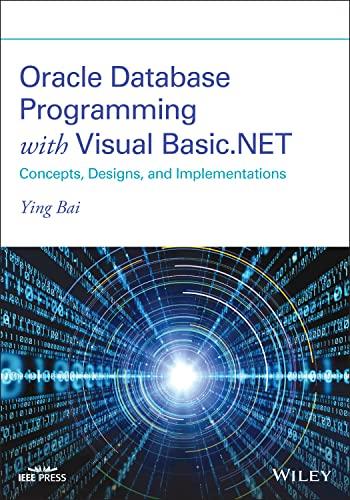Answered step by step
Verified Expert Solution
Question
1 Approved Answer
You are expected to derive the requirement based test cases for a program that displays the contents of memory locations, by using Cause Effect Graphing
You are expected to derive the requirement based test cases for a program
that displays the contents of memory locations, by using Cause Effect Graphing
technique. Here is the requirement specification for the program to be tested:
The SHOWMEM command is to observe the contents of memory locations from a
terminal window. The command syntax is provided below. Brackets denote optional
operands, and the various alternative values that can be provided for those optionaloperands. Uppercase letters signify operand keywords, while lowercase letters stand
for operand values which are to be replaced with actual values Underlined operands
indicate default values ie the value used when the operand is omitted
The initial operand hexloc determines the address of the first byte whose contents
are to be shown. This address can be one to six hexadecimal digits AF long. If
not specified, the address defaults to The address must fall within the actual
memory range of the machine.
The second operand specifies the amount of memory to be displayed. If hexloc is
specified, it defines the address of the last byte in the range of locations to be
displayed. It may be one to six hexadecimal digits in length. The address must be
greater than or equal to the starting address hexloc Also, hexloc must be within
the actual memory range of the machine. If END is specified, memory is displayed
up through the last actual byte in the machine. If bytecount is specified, it defines the
number of bytes of memory to be displayed starting with the location specified in
hexloc The operand bytecount is a hexadecimal integer one to six digits The sum
of bytecount and hexloc must not exceed the actual memory size plus and
bytecount must have a value of at least When the second operand is omitted, it is
assumed to be by default.
When memory contents are displayed, the output format on the screen is one or
more lines of the format
xxxxxx bytebyte byte byte
where xxxxxx is the hexadecimal address of byte All output lines will always contain
four bytes, regardless of the value of hexloc or the amount of memory to be
displayed.
The error messages that can be produced are:
E is invalid command syntax.E memory requested is beyond actual memory limit
E memory requested is a zero or negative range.
Some examples of the command usage are:
SHOWMEM displays the first byte in memory default starting address
of default byte count of
SHOWMEM F displays the byte at address F
SHOWMEM FA displays the bytes in the address range FA;
After analysis of the specification, following causes and effects have been identified:
Causes:
First operand is present.
The first operand contains only hexadecimal digits.
The first operand contains one to six characters.
The first operand is within the actual memory range of the machine.
Second operand is END.
Second operand is hexloc.
Second operand is bytecount.
Second operand is omitted.
The hexloc operand contains only hexadecimal digits.
The hexloc operand contains one to six characters.
The hexloc operand is within the actual memory range of the machine.
The hexloc operand is greater than or equal to the hexloc operand.
The bytecount operand contains only hexadecimal digits.
The bytecount operand contains one to six characters.
bytecount hexloc memory size
bytecount
Specified range is large enough to require multiple output lines.
Effects:
Message E is displayed.
Message E is displayed.
Message E is displayed.
Memory is displayed on one line.
Memory is displayed on multiple lines.
Convert the Cause Effect Graph you constructed in a above toa limited entry
decision table, by following the technique and rules we have seen during our lecture
Week
Step by Step Solution
There are 3 Steps involved in it
Step: 1

Get Instant Access to Expert-Tailored Solutions
See step-by-step solutions with expert insights and AI powered tools for academic success
Step: 2

Step: 3

Ace Your Homework with AI
Get the answers you need in no time with our AI-driven, step-by-step assistance
Get Started


